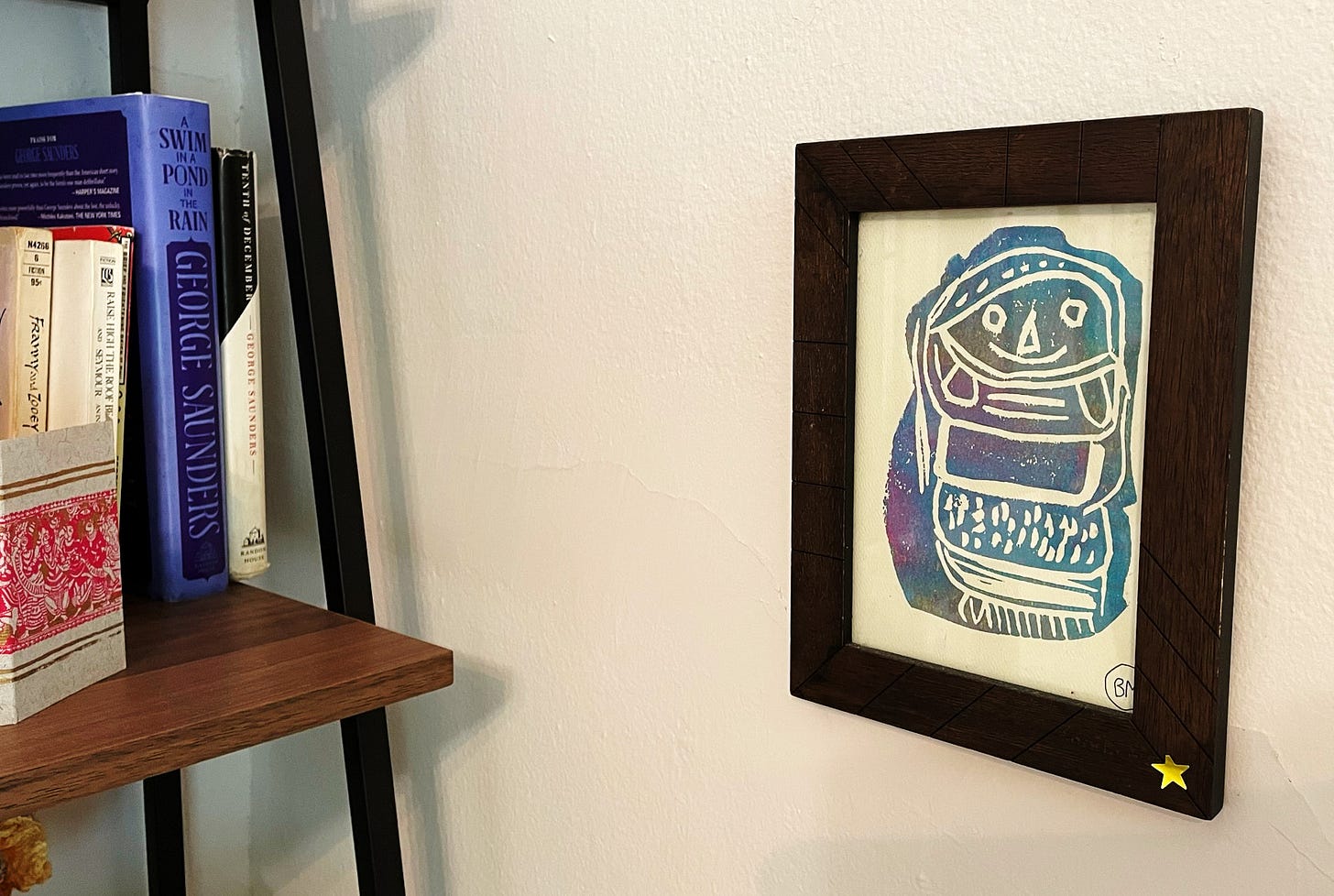Anyone else feel busy this July? We’re taught as kids that summer is the time to let your brain unspool and walk around without shoes. (You, not your brain.) But as an adult, I feel like I don’t get to really rest until winter. Lately, I’ve been buzzing around the city, meeting new faces, in preparation for the Big Thing that I’m not quite ready to share. Just give me two more weeks or so. It’ll be great.
Until then, I have another Snack Time, the shorter and more spontaneous installments of this newsletter. Though in this case, the appellation feels a little off. Maybe Unpack Time. Or Taken Aback Time? Abstract Time?
Anyway, look at this:

Like it? It’s a block print Sarah brought home from work one day, maybe as long as four years ago. I’ve never quite decided whether it’s meant to depict a Russian grandmother tending needlework, an infant making a mess in her high chair, or just a friendly totem bidding welcome. I’ve always had the feeling she’s female. Maybe I’m reading the vertical line on the left as hair, and the strokes at the bottom as the frayed hem of a dress. In any case, it’s pretty clear she’s having a good day.
I never met the guy who made it, though Sarah knew him well. Are you, um, in the mood for a sad story? Or a happy story with some parts that make you, in a roundabout way, consider the conditions of your mortal existence? Fair warning.
B was a resident at the assisted living facility Sarah worked at. We had just started dating and talked about everything, but the work stories were always my favorite. Starring roles were filled by the residents under her care, and she dutifully invented pseudonyms for each of them. There was Madame, Janeway, the PBRs, Favorite Resident, and Favorite Resident Junior. I only learned B’s first name much later. For years he was just The Boss.
The Boss’s nickname was better earned than any other. A mid-stage dementia patient, he spent his later days living with the unwavering conviction that he was a high-ranking corporate executive, and that the staff and other residents were his subordinates. He wasn’t the most disruptive resident, but if your job was to ensure his general well-being, his behavior could be problematic. You might, for example, find him padding down the hall with a Ziploc bag tucked under his arm. And if you asked him why, inside the bag, there was a lettuce leaf the size of a Frisbee, he might simply claim, “I always have this,” and wave you off like the insignificant underling he assumed you were.
They gave him a clipboard to keep him occupied. When caring for dementia patients, redirection is the name of the game. This struck me as strange at first, but it’s often the reality of elder care. Rather than simply “snapping them out of it” the goal is to channel otherwise harmful or disruptive behaviors into something positive.
He carried the clipboard at all times and kept it packed with any official-looking document he could lay his hands on, as well as printouts provided to him by the social worker. On these, he tallied the number of men and women in the dining room that day, what he ate for dinner, and whether or not it was any good. He treated it like real work and soon he was toting an inch-thick stack of paperwork with him everywhere he went.
Later, some portion of his work ethic had been converted into making art. Again, redirection at its finest. He made acrylic prints and paintings, mostly on paper but some on larger canvasses. He attended to it with the same zeal as his paperwork, and soon he was the most prolific artist among the residents. He made dozens of pieces, which he exhibited down long stretches of hallway at the twice-yearly resident art show.
We can only guess that The Boss spent much of his earlier life in an office, playing out the role of a restless workaholic day by day. It’s possible he returned to them in his old age because they were familiar, or even comforting. It’s not uncommon, as many dementia and Alzheimer’s patients revert back to first languages, mention recent visits with long-dead family, even retain a lexicographic memory of 40-year-old Toronto cab routes. It’s like reminiscing, except you invite your fondest or most palpable memories out into the open where anyone can see them.
In my personal experience, I’ve found that mental decline serves to relieve us of our less essential qualities, returning us to who we are at our most basic. Some people become quiet and gentle, others not so much. Maybe it strikes you as sad, a man still grinding away at his 9 to 5 decades after retirement. It does me. But let’s ask ourselves: what patterns are etching themselves into our memories, today, this month or this year, that we’ll still be tracing by the end of our lives? And consider, if you’re still with me down here, whether The Boss’s tireless sense of purpose is something we should pity or admire.
So, yeah. I’ve been reading a lot of Tolstoy lately, and am maybe a little overprimed for, um, whatever it was that just happened here. How do I end this?
I guess just to point out that, ultimately, The Boss and I agree that art is a form of work. And that work, whether it’s making pictures or trading shares of Union Pacific, isn’t anything less than activated purpose. We may hope that some evidence of this purpose will still be hanging around for, you know, at least a while after we’re gone.
Thanks for reading! The next one will be less sad. Happy, one might even say.





it's a great story-Sarah's telling and your writing!
1
I love the picture and the story behind it!